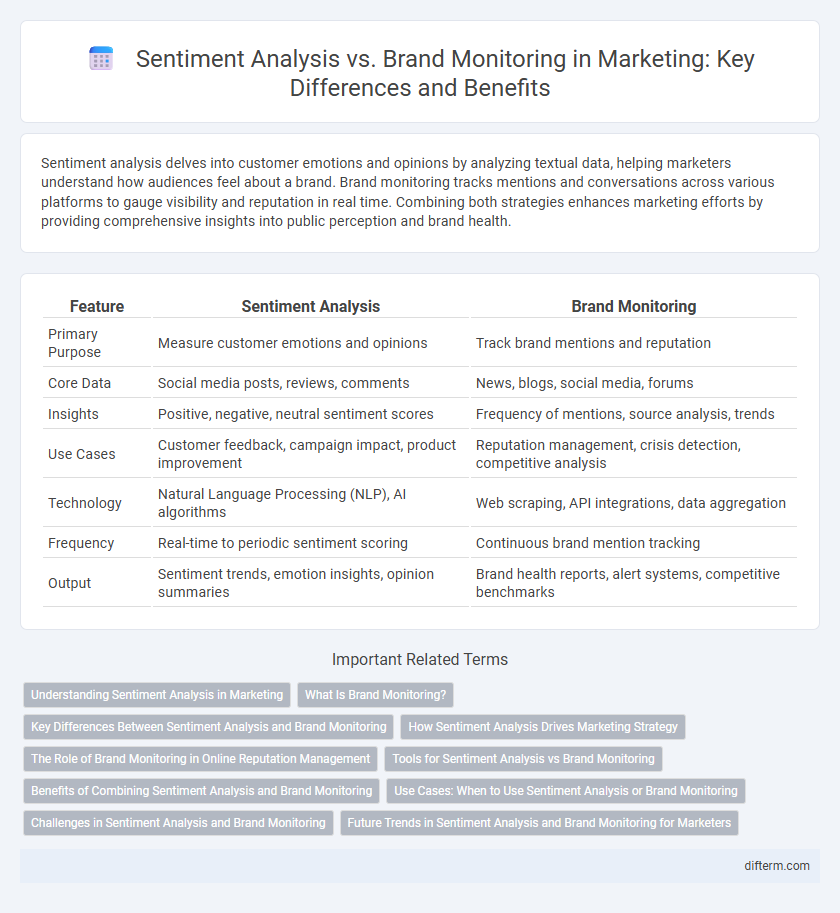Sentiment analysis delves into customer emotions and opinions by analyzing textual data, helping marketers understand how audiences feel about a brand. Brand monitoring tracks mentions and conversations across various platforms to gauge visibility and reputation in real time. Combining both strategies enhances marketing efforts by providing comprehensive insights into public perception and brand health.
Table of Comparison
| Feature | Sentiment Analysis | Brand Monitoring |
|---|---|---|
| Primary Purpose | Measure customer emotions and opinions | Track brand mentions and reputation |
| Core Data | Social media posts, reviews, comments | News, blogs, social media, forums |
| Insights | Positive, negative, neutral sentiment scores | Frequency of mentions, source analysis, trends |
| Use Cases | Customer feedback, campaign impact, product improvement | Reputation management, crisis detection, competitive analysis |
| Technology | Natural Language Processing (NLP), AI algorithms | Web scraping, API integrations, data aggregation |
| Frequency | Real-time to periodic sentiment scoring | Continuous brand mention tracking |
| Output | Sentiment trends, emotion insights, opinion summaries | Brand health reports, alert systems, competitive benchmarks |
Understanding Sentiment Analysis in Marketing
Sentiment analysis in marketing involves using natural language processing to evaluate consumer emotions and opinions from social media, reviews, and surveys, providing real-time insights into customer attitudes. This technique helps brands identify positive, negative, or neutral sentiments, enabling targeted campaign adjustments and improved customer engagement. Unlike brand monitoring, which tracks overall brand presence and mentions, sentiment analysis delivers deeper emotional context crucial for refining marketing strategies.
What Is Brand Monitoring?
Brand monitoring involves tracking and analyzing online mentions of a company, product, or service across social media, review sites, forums, and news outlets to understand public perception and manage reputation. It helps businesses identify emerging trends, customer feedback, and potential crises in real-time, enabling proactive engagement and strategic decision-making. Unlike sentiment analysis, which focuses on interpreting emotions within data, brand monitoring provides a comprehensive overview of brand visibility and mentions across multiple channels.
Key Differences Between Sentiment Analysis and Brand Monitoring
Sentiment analysis uses natural language processing to evaluate customers' emotions and opinions expressed in social media, reviews, and other textual data, providing insights into public perception. Brand monitoring involves tracking brand mentions across various platforms in real time to gauge visibility, reputation, and potential PR issues. While sentiment analysis focuses on emotional tone and polarity of specific content, brand monitoring offers a broader overview of brand presence and trend identification.
How Sentiment Analysis Drives Marketing Strategy
Sentiment analysis deciphers consumer emotions by evaluating social media posts, reviews, and feedback to gauge brand perception. This data empowers marketers to tailor campaigns, improve customer engagement, and anticipate market trends effectively. Integrating sentiment analysis with brand monitoring enhances strategic decision-making by providing real-time insights into consumer attitudes and competitive positioning.
The Role of Brand Monitoring in Online Reputation Management
Brand monitoring plays a crucial role in online reputation management by continuously tracking mentions, reviews, and conversations about a brand across various digital platforms to identify potential risks and opportunities in real-time. Unlike sentiment analysis which primarily gauges the emotional tone of customer feedback, brand monitoring provides comprehensive insights into brand perception, enabling proactive responses to negative content and reinforcing positive engagement. Effective brand monitoring ensures sustained reputation health by integrating data from social media, review sites, forums, and news outlets, allowing marketers to maintain control over their brand narrative and improve customer trust.
Tools for Sentiment Analysis vs Brand Monitoring
Sentiment analysis tools leverage natural language processing to automatically detect and categorize emotions in customer feedback, enabling precise measurement of consumer attitudes toward a brand. Brand monitoring tools track real-time mentions across social media, news, and forums to provide comprehensive visibility of brand reputation and competitive positioning. Integrating both tool types enhances marketing strategies by combining emotional insight with ongoing reputation tracking for proactive brand management.
Benefits of Combining Sentiment Analysis and Brand Monitoring
Combining sentiment analysis and brand monitoring enhances marketing strategies by providing deeper insights into consumer emotions and brand perception across multiple platforms. This integration enables real-time tracking of brand reputation and customer feedback, facilitating proactive response to potential crises and improving customer engagement. Leveraging these tools together boosts data accuracy and decision-making, driving more effective marketing campaigns and stronger brand loyalty.
Use Cases: When to Use Sentiment Analysis or Brand Monitoring
Sentiment analysis excels in assessing customer emotions and opinions during product launches or campaign evaluations, enabling marketers to gauge public reaction and tailor messaging accordingly. Brand monitoring is essential for tracking overall brand reputation, detecting crises early, and managing customer feedback across social media, review sites, and forums. Using sentiment analysis helps optimize targeted marketing strategies, while brand monitoring supports ongoing brand health management and competitive intelligence.
Challenges in Sentiment Analysis and Brand Monitoring
Sentiment analysis faces challenges such as accurately interpreting sarcasm, context, and mixed sentiments within social media posts, which can lead to misclassification of consumer emotions. Brand monitoring struggles with filtering vast amounts of unstructured data, distinguishing between genuine customer feedback and spam, and tracking brand mentions across multiple languages and platforms. Both require advanced natural language processing (NLP) techniques and real-time analytics to deliver precise insights for effective marketing strategies.
Future Trends in Sentiment Analysis and Brand Monitoring for Marketers
Future trends in sentiment analysis and brand monitoring emphasize advanced AI-driven algorithms that enhance real-time data processing and predictive analytics. Marketers will increasingly leverage natural language processing to capture nuanced consumer emotions across diverse platforms, enabling more personalized and targeted campaigns. Integration of multimodal data sources, such as visual and textual content, will provide deeper insights into brand perception and customer engagement.
sentiment analysis vs brand monitoring Infographic

 difterm.com
difterm.com